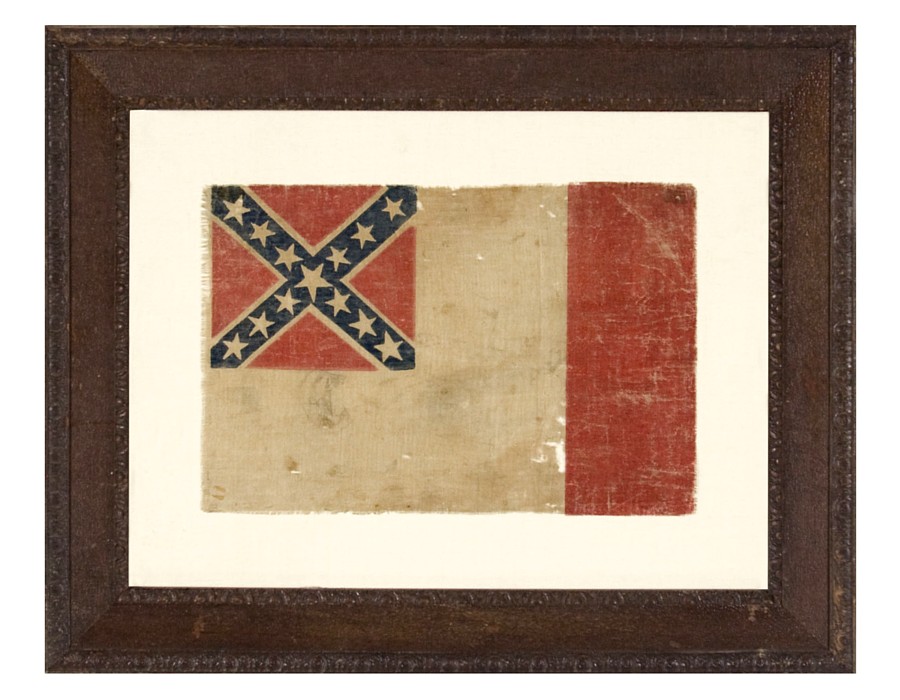
| |
VERY RARE CONFEDERATE PARADE FLAG IN THE 3RD NATIONAL CONFEDERATE FORMAT, PROBABLY PRODUCED IN THE MID-LATE 1880'S WITH THE FORMATION OF THE UDC AND THE UCV |
|
| Available: |
Sold |
| Frame Size (H x L): |
17.75" x 22.25" |
| Flag Size (H x L): |
9" x 13.5" |
|
| Description....: |
|
VERY RARE CONFEDERATE PARADE FLAG IN THE 3RD NATIONAL CONFEDERATE FORMAT, PROBABLY PRODUCED IN THE MID-LATE 1880'S WITH THE FORMATION OF THE UDC AND THE UCV:
Very rare Confederate parade flag in the Third National format. Block printed on coarse, glazed cotton, this is perhaps equivalent to the earliest example that I have ever encountered in any parade flag of the reunion era. In addition it is the only one I have ever encountered in this exact variety.
Note in the great variation in the shape and size of the arms of the stars. A larger center star is always a nice feature; note how the star is upside-down in its orientation on this particular example. This would have had no intended purpose, but it is peculiar to the modern eye and adds to the attractive nature of the overall design, which has very strong folk qualities.
Based on the printing and what is known about surviving Confederate parade flags and their probable use, this one was likely produced during the 1880's. The crude stars are more indicative of examples made during and prior to the 1876 era than they are among those made afterward, like this one. The flag would either have been made for use by the United Daughters of the Confederacy (UDC), which was established in 1884 and thus pre-dated the United Confederate Veterans (UCV), which formed in 1889 and served as the primary post-war organization for Confederate soldiers. The women came first because it was safer for them to organize than it was for the men.
The Confederacy had three successive national designs, known as the first, second, and third confederate national flags. The original first confederate design looked much like the Stars & Stripes. It consisted of 7 white stars arranged in a blue canton, and three linear stripes instead of thirteen (2 red with one white in-between). This is the flag known as the Stars & Bars. Because they were so alike, use of the Stars & Stripes and the Stars & Bars on the same battlefield created great confusion. For this reason, the second Confederate flag was adopted on May 26th, 1863. It was white in color, with the Southern Cross (the Confederate battle flag) serving as its canton. Soldiers and officers alike disliked this design because it looked too much like a surrender flag, and, if given the opportunity, they would dip the end in blood.
36 days before the war's end a red vertical bar was added at the fly end and the result became the third national design. This was the "blood stained banner", but officially it did not represent blood, but rather paid homage to the French, who lent aid to the South during the war. Note how if you were to replace the first third of the flag with a blue vertical bar, the result would be the French tri-color, the national flag of France.
Many people are surprised to learn that the Southern Cross, by itself, was not the national flag of the Confederate States of America. Officially, in rectangular format, it served as the Confederate Navy Jack. In square format it came to be called "the battle flag", partly because it was carried in this format, for that purpose, by Robert E. Lee and his Army of Northern Virginia, as well as by Beauregard's Army and others. It also received widespread love in the South because the second and third national designs were not particularly admired by Confederate soldiers, the second for reasons previously stated and the third because the design was so short-lived.
Mounting: The solid oak or chestnut frame has pressed decoration along both the inner and outer edges and dates, retains its original varnished surface with great craquelure, and dates to the same period as the flag (ca 1880-90). The flag has been hand-stitched to 100% hemp fabric. Spacers keep the textile away from the glass, which is U.V. protective.
Condition: There is minor to moderate foxing and staining throughout, accompanied by minor fabric loss in the white portion of the field and minor fraying along the edges. The wear is particularly attractive. Many of my clients actually prefer early flags to show their age and history of use. |
|
|
|
| Collector Level: |
Advanced Collectors and the Person with Everything |
|
| Flag Type: |
Parade flag |
|
| Star Count: |
Other |
|
| Earliest Date of Origin: |
1884 |
|
| Latest Date of Origin: |
1890 |
|
| State/Affiliation: |
The Confederacy |
|
| War Association: |
1861-1865 Civil War |
|
| Price: |
SOLD |
|
| |
Views: 3885 |
|
|
|

